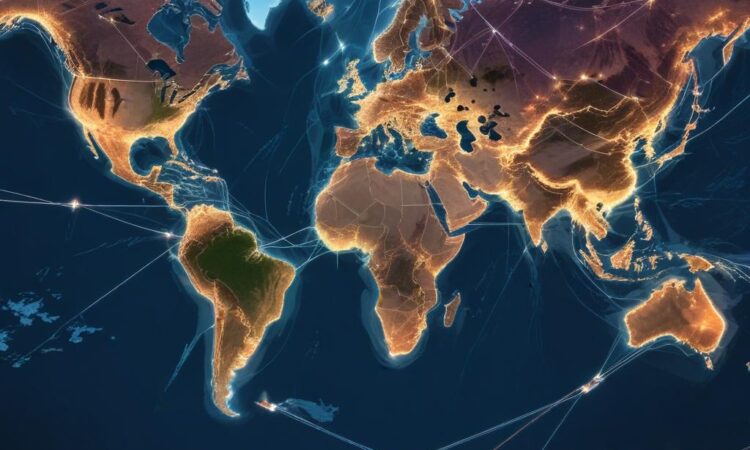Supply Chain Disruptions and Global Trade: A Global Challenge
The global economy is grappling with a complex web of challenges, and among the most pressing issues are the persistent supply chain disruptions that have rippled across industries and continents. These disruptions, particularly in the technology and manufacturing sectors, have had a profound impact on global trade and economic growth, prompting urgent calls for analysis, solutions, and long-term resilience.
The Roots of the Disruptions: A Multifaceted Crisis
The current supply chain crisis is not a singular event but a confluence of factors that have converged to create a perfect storm of disruption. The following are some of the key drivers:
1. The COVID-19 Pandemic: A Catalyst for Change
The COVID-19 pandemic acted as a catalyst, exposing vulnerabilities in global supply chains that were already under pressure. Lockdowns, travel restrictions, and labor shortages disrupted production and logistics, leading to delays, backlogs, and shortages in essential goods and raw materials.
2. Geopolitical Tensions: A Strain on Trade
Rising geopolitical tensions, particularly between major economic powers, have contributed to supply chain disruptions. Trade wars, sanctions, and protectionist policies have created uncertainties and barriers to global trade flows. This has forced businesses to diversify their supply chains, often at higher costs.
3. Climate Change: A Growing Threat
Climate change is increasingly posing a significant threat to global supply chains. Extreme weather events, such as floods, droughts, and storms, can disrupt transportation networks, damage infrastructure, and impact agricultural production. These disruptions can have cascading effects throughout the supply chain, leading to shortages and price volatility.
4. Digital Transformation: A Double-Edged Sword
The rapid adoption of digital technologies has brought both benefits and challenges to supply chain management. While automation and data analytics can improve efficiency and transparency, the reliance on complex IT systems and interconnected networks can make supply chains more vulnerable to cyberattacks and data breaches.
The Impact on Global Trade: A Slowdown in Growth
The ongoing supply chain disruptions have had a significant impact on global trade, leading to a slowdown in economic growth and increased costs for businesses and consumers. The following are some of the key consequences:
1. Reduced Trade Volumes: A Contraction in Global Trade
The disruptions have led to a decline in global trade volumes as businesses struggle to secure essential goods and raw materials. This has had a ripple effect on economic activity, reducing manufacturing output and slowing down global GDP growth.
2. Increased Prices: Inflationary Pressures
Supply chain disruptions have driven up prices for a wide range of goods and services. The scarcity of essential commodities, coupled with increased transportation and labor costs, has fueled inflation and eroded consumer purchasing power.
3. Uncertainties in Supply: A Loss of Confidence
Businesses are facing increased uncertainty regarding their ability to access essential inputs and meet customer demand. This uncertainty is dampening investment and hindering economic growth, as companies are hesitant to commit to long-term projects.
4. Business Disruptions: Challenges to Operations
Supply chain disruptions have forced businesses to adjust their operations, leading to production delays, stock shortages, and difficulties in meeting customer orders. This has resulted in lost revenue and decreased profitability for many businesses.
Navigating the Challenges: Towards Resilience and Sustainability
Addressing the challenges of supply chain disruptions requires a multifaceted approach that involves collaboration between governments, businesses, and stakeholders across the global economy. The following are some key strategies for building more resilient and sustainable supply chains:
1. Diversification of Supply Sources: Reducing Dependence
Businesses can mitigate the risk of disruptions by diversifying their supply sources, reducing their dependence on single suppliers or geographical regions. This can involve sourcing from multiple locations, developing alternative suppliers, and exploring new technologies and materials.
2. Inventory Management: Optimizing Stock Levels
Effective inventory management is crucial for mitigating supply chain disruptions. Businesses can use data analytics and forecasting models to optimize their stock levels, ensuring they have sufficient inventory to meet customer demand while avoiding excessive holding costs.
3. Improved Visibility and Transparency: Tracking Goods in Real Time
Real-time visibility into supply chains is essential for identifying potential disruptions and responding quickly. Advanced technologies, such as blockchain and Internet of Things (IoT) devices, can be used to track goods throughout their journey, providing valuable insights into their location and status.
4. Strengthening Partnerships: Collaboration and Cooperation
Building strong partnerships with suppliers, logistics providers, and other stakeholders is essential for navigating supply chain disruptions. Collaboration and information sharing can help businesses anticipate problems, share resources, and coordinate responses to disruptions.
5. Government Policies: Fostering Innovation and Resilience
Government policies play a crucial role in promoting resilience in global supply chains. This includes measures to support research and development, promote infrastructure investments, facilitate trade liberalization, and enhance regulatory frameworks for supply chain security.
Conclusion: A Call for Collaborative Action
The ongoing supply chain disruptions pose a significant challenge to global trade and economic growth. Addressing these challenges requires a collaborative effort from all stakeholders, involving governments, businesses, and consumers. By diversifying supply sources, optimizing inventory management, enhancing visibility and transparency, fostering strong partnerships, and implementing supportive policies, we can work towards building more resilient and sustainable supply chains that can withstand future disruptions and contribute to a more stable and prosperous global economy.

